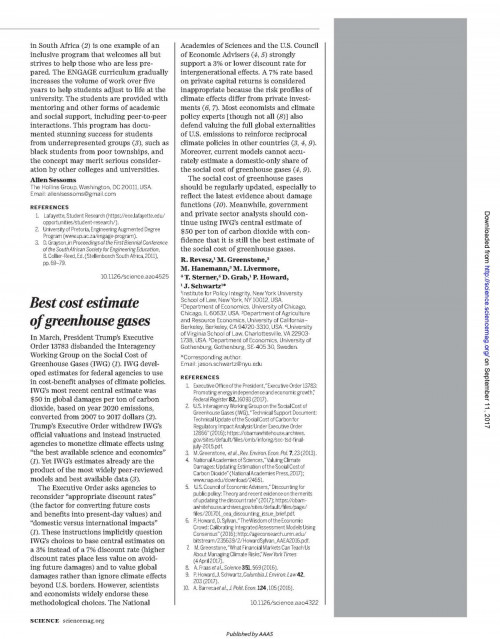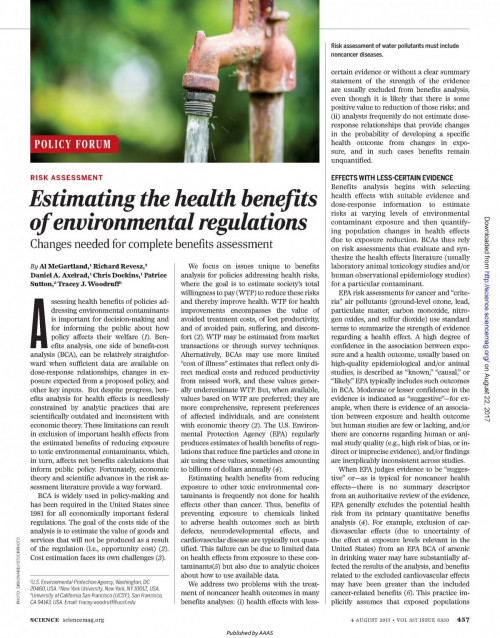-
Amicus Brief on Bureau of Land Management’s Waste Prevention Rule
The Bureau of Land Management’s (BLM’s) Waste Prevention Rule, enacted on November 18, 2016, sought to prevent oil and gas companies from wasting natural gas produced on public land. In June 2017, BLM stayed the rule by indefinitely postponing key compliance deadlines. In response, the states of California and New Mexico as well as several environmental organizations filed suit against BLM in the U.S. District Court for the Northern District of California. In our amicus brief in support of the plaintiffs, we argue that BLM failed to provide a reasoned explanation for the stay, as required by the Administrative Procedure Act, because BLM ignored the forgone benefits of the Waste Prevention Rule.
-
Comments to OSHA on Beryllium Standards Revocation
In public comments to the Occupational Safety and Health Administration, we highlight some critical problems with the agency’s cost-benefit analysis in its proposed revocation of standards to protect workers from exposure to beryllium. These ancillary standards were designed to protect workers in the construction and shipyard sectors.
-

Best Cost Estimate of Greenhouse Gases
Despite the Trump administration’s decision to withdraw the official estimate of the Social Cost of Carbon and disband the interagency working group that developed it, a group of prominent economists and lawyers, including several Policy Integrity staff members, have highlighted the metric’s continued validity for policymaking in recent letter published in the journal Science.
-
Public Comments on Regulatory Review (Treasury, GSA, FEMA, State, DOJ, FCA, Interior)
Many federal agencies are requesting the public’s suggestions for rules to repeal or reform, tacitly implying that most regulations stifle economic growth. In comments to several agencies, we argue that regulatory review should consider the public benefits of regulation, not just the costs to regulated industries, and should prioritize review of rules for which actual costs and benefits diverge significantly from predicted costs and benefits.
-
Comments on FEMA’s Proposal on Public Petitions
The Federal Emergency Management Agency (FEMA) is proposing to update its regulations on the rulemaking process, which include amendments to how it accepts and considers public petitions for rulemaking. While the proposed changes are all appropriate, we offer additional changes that would increase government transparency in our comments to the agency.
-
Comments to EPA on Delaying Methane Rule
In 2016, EPA issued a rule to decrease methane and volatile organic compound emissions from new, modified, and reconstructed sources in the oil and natural gas sector. EPA has now proposed to suspend some of the rule’s compliance obligations for two years while the agency decides whether and how to revise those requirements. The U.S. Court of Appeals for the D.C. Circuit rejected an earlier attempt by EPA to stay the methane rule for 90 days, and our comments argue that the new proposal is similarly unlawful.
-

Estimating the Health Benefits of Environmental Regulations
Regulating toxic pollutants benefits society by limiting public exposure to harmful pollution. By accurately quantifying these benefits, policymakers can improve the design of regulations that protect public health and better communicate the magnitude of these protections to the public. A new article in the journal Science examines how this process can be improved.
-
Comments to Minnesota on the Social Cost of Carbon
The Minnesota Public Utility Commission (PUC) updated its social cost of carbon (SCC) values last week to a range of approximately $9 to $43, drawing from the 2015 Interagency Working Group (IWG) estimates. Minnesota’s use of the IWG SCC values recently came under scrutiny by industry groups in the state, who cited the recent energy executive order as reason to revisit the PUC externality estimates. After initial oral arguments, parties were invited to submit revised SCC values. Accordingly, we shared our recent comments to the U.S. Army Corps of Engineers, along with a cover letter explaining the importance of our analysis to the PUC.
-
Comments on Forest Service’s West Elk Mine Environmental Impact Statement
In its new Environmental Impact Statement (EIS) for the expansion of the West Elk coal mine in Colorado, the Forest Service fails to monetize climate damages. It claims that these methods are not appropriate at the project level, that the court ruling was issued prior to an executive order withdrawing federal guidance on these estimates and thus no longer applies, and that the EIS did not selectively exclude climate impacts because it also does not monetize other benefits or costs. We argue that these justifications are inadequate in our joint comments with the Environmental Defense Fund, the Natural Resources Defense Council, the Sierra Club, and the Union of Concerned Scientists.
-
Public Comments on the Review of National Monuments
We recently submitted comments to the Department of the Interior on their review of certain national monuments established since 1996. The review process was initiated by Executive Order 13792, which directs the Secretary of the Interior to review all national monuments designated or expanded after January 1, 1996, that either include more than 100,000 acres of public lands or for which the Secretary determines inadequate “public outreach and coordination with relevant stakeholders” occurred.
